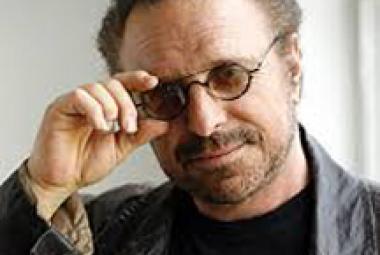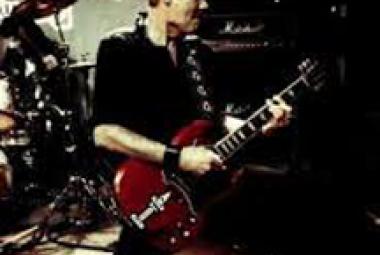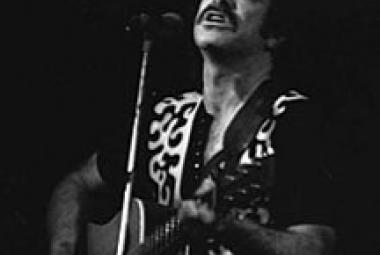UNDER-APPRECIATED ROCK BAND OF THE MONTH FOR JANUARY 2014: BOYSKOUT
BOYSKOUT, this month’s Under-Appreciated Rock Band are pretty open about being a lesbian band – they used the term “rad queer band” in one interview. Though neither their Allmusic write-up nor the Bomp! Records packaging mentions this. the name of the last song on the album, “Girl on Girl Action” gives it away if you hadn’t already figured it out.
However, “queer” might be a better term than lesbian. When asked in a 2009 interview, “Are you lesbians? Bi-sexual? Are you just experimenting? Are you all like that or just some of you?”, bandleader Leslie Satterfield responded, “Yes”, then continued: “We don’t want to be pigeonholed into a stereotype. I for one have had relationships with men as well, but I don’t want to be labeled as ‘Bi’ or any other label. It really depends on the person for me.”
* * *
Like the women’s music pioneers before them, there is hardly any sexuality on the Boyskout songs; and anyone can enjoy this CD, which sounds great on the first spin and only gets better over time. Even on “Girl on Girl Action”, the sexy mood of the breathey vocals is undercut by a very slow rendition of the iconic quote from the chorus of “Is That All There Is?”: “If that’s all there is, my friends, then let’s keep dancing / Let’s break out the booze and have a ball”.
* * *
Even in the context of 1969 – one of the most eclectic years in the history of music (if I remember right, there was once a television program on the music in that year) – “Is That All There Is?” hit the record charts utterly out of left field. Particularly as performed in the version by Peggy Lee – who was previously best known for her hit “Fever” in the late 1950’s (with “Fever” later becoming probably the best known cover song by Madonna) – “Is That All There Is?” seems to come off like a 1940’s-style pop song. The verses tell of the singer’s growing disillusionment with life – first at a house fire, then at a circus, and finally at love – followed by the chorus (the only part that is sung): You can almost see her world-weary shrugs in the way that Peggy Lee sings those lines. In a final twist, the chorus is cut short before the last verse where the singer has decided that suicide is no answer either: “I’m not ready for the final disappointment.”
In a sense, “Is That All There Is?” is a grimmer retelling of the Joni Mitchell song “Both Sides Now” that Judy Collins released as a Top 10 hit the previous year; it had appeared on Collins’ 1967 album, Wildflowers. For all I know, that could have been the genesis of the song. The first recorded version, by New York disc jockey Dan Daniel was released in March 1968.
The song was written by the prolific songwriting team of Jerry Leiber and Mike Stoller. “Is That All There Is?” has little in common with their better known songs like “Jailhouse Rock”, “Hound Dog”, “Kansas City”, or the numerous hits by the Coasters; although songs that the two co-wrote with others, such as “Stand by Me” and “On Broadway” have some of the flavor of this song.
The piano work along with the arrangements on the Peggy Lee hit version of “Is That All There Is?” were by Randy Newman at the beginning of his career (he was also the orchestra conductor) – his debut album, Randy Newman came out in 1968 – and there is no doubt that this song was right up his alley.
Peggy Lee won the Grammy Award for Best Female Pop Vocal Performance for “Is That All There Is?”, and the song was later inducted into the Grammy Hall of Fame.
* * *
If I had to guess, I would imagine that Boyskout heard “Is That All There Is?” as performed by PJ Harvey for the soundtrack of the film, Basquiat (1996) rather than the Peggy Lee hit version of “Is That All There Is?”. Past UARA Thomas Anderson once perversely said that his favorite singer-songwriter is Iggy Pop; and there seems to be no other category in which to place Polly Jean Harvey either. Harvey grew up on a sheep farm in Yeovil, England; her father worked in a quarry, and her mother was an artist. She learned to play the guitar and saxophone at an early age and was a backing musician in her teens.
Polly Jean Harvey formed a trio in 1991 called PJ Harvey with Steve Vaughan (bass guitar) and Robert Ellis (drums). They became a sensation on the indie-rock circuit, with their debut album Dry (1992) and particularly Rid of Me (1993) being released to wide acclaim. I don’t have Harvey’s early albums yet, though I do have 4 Track Demos that show the material on Rid of Me in a different format. While the intention was to present the PJ Harvey songs in a less abrasive form than the original CD, it is hard to conceive of demos being noisier and at the same time more complete than on 4 Track Demos; normally, a demo is laid down in an unadorned, often acoustic manner in order to establish the copyright and to provide a backbone for the finished track.
By this time, the original trio had broken up, and Harvey was now on her own; but she continued to release her albums under the name PJ Harvey with her full name Polly Jean Harvey given in the credits.
My favorite PJ Harvey album thus far (and also the first one that I purchased, though I had heard about her for years), Stories From the City, Stories From the Sea (2000) is drawn from a six-month sojourn in New York City in 1999. I had been thinking that the album was her response to 9/11; it was actually released before that horrific date, but there is a sense of impending doom on many of these songs, particularly on “One Line” and her duet with Radiohead’s Thom Yorke, “This Mess We’re In”. PJ Harvey’s thrilling video for “This Is Love” is what originally grabbed me; the song has the memorable lyric: “I can’t believe life is so complex / When I just want to sit here and watch you undress.”
For years, I couldn’t play Stories From the City, Stories From the Sea often enough or loud enough. The opening track, “Big Exit” became the song that I lived by for a long time: “I met a man / He told me straight / ‘You gotta leave / It’s getting late’ / Too many cops / Too many guns / All trying to do something / No-one else has done” (though I heard the last line as “I’m trying to do something no one else has done”).
* * *
By the way, there are no boys in Boyskout, just like there are no girls in the Lazy Cowgirls – but, oh, if you think outlaw country is a treat (as I do), you should hear the outlaw rock that Pat Todd and the boys lay down in their albums, from Tapping the Source onward.
* * *
Okay, enough detours; let me get back to the UARB. In 2001, Leslie Satterfield (guitar and vocals) was offered the opportunity to be the opening act for her favorite rock band, an Olympia, WA experimental duo called The Need. Unfortunately, she didn’t yet have a rock band to do the job and only three weeks until the concert; so she quickly recruited several friends, first drummer Caroline Mills – they were in a band together though I am not sure the name of it. China Lajczock (keyboards and most of the lead vocals) had been working in a coffee shop, and the other bandmembers met Hannah Reiff (bass guitar) by buying her a drink on “dollar drink night” at a dive somewhere.
While the band was being put together, they saw a news story about a gay troop leader who was being forced out of the Boy Scouts; so they figured that having a lesbian band take the name Boyskout would really offend them. Happily, the ban on openly gay Boy Scouts was finally lifted as of January 1, 2014.
* * *
Boyskout initially put out a single on clear vinyl in 2003 on Isota Records, “Secrets” b/w “Pictures from the Moon”. Their music caught the attention of the Bomp! Records label Alive Records, which included two Boyskout songs on their compilation album, The Sound of San Francisco. The two songs were “Secrets” and “School of Etiquette” – of these three early songs, only “Secrets” is on the Alive CD, even though the name of the CD is School of Etiquette. Boyskout recorded their first album in April 2003 and November 2003 with the assistance of Daniel Dietrick on bass guitar and keyboards. The producer is Jeff Saltzman; in the same year he produced the debut album Hot Fuss for the Killers, another successful entry in the Garage Rock Revival of the early 2000’s (the band’s name is taken from the nickname of rockabilly pioneer Jerry Lee Lewis, “Killer”).
I have previously written of The Sound of San Francisco and quoted nearly all of Mick Farren’s liner notes for that album; this is the first (though not the last) UARB to be drawn from the roster. My tribute to Mick Farren is coming up later this year; his death last year upset me as much as any I can think of from the music world since that of John Lennon.
* * *
The debut album by Boyskout, School of Etiquette came out on Alive Records in January 2004. Mark Jenkins with the Washington Post has written of this album: “If some CBGB's Frankenstein had managed, circa 1977, to transplant Patti Smith’s sensibility into Blondie’s garage-band pop, the result would have sounded something like BoySkout’s School of Etiquette. Outfitted in such New Wavey accessories as sneakers and skinny ties, this lesbian-rock quartet revives such Smithian motifs as drowning and the erotic appeal of outlaws, but with girl-group bounce. School of Etiquette may not be genteel, but it is impeccably arranged.”
Boyskout’s music is more new wave than riot grrrl; other ingredients are old-style punk sensibilities plus a love of catchy pop tunes, and it seems clear to me that the bandmembers have been enjoying their Sleater-Kinney albums. The songs have an underlying current of angst and suspicion coupled with a sense of fun. For instance, the anxious music on “Secrets” creates a feeling of foreboding underlying these lyrics: “She told you all my secrets / She knew them all so well / She told you all my secrets / . . . She promised not to tell . . .”
* * *
School of Etiquette includes another song called “Back to Bed”; Leslie Satterfield thinks that a playful video for this song was misunderstood. In a 2009 interview for an online magazine called The New Gay, she was asked about “inter-band dating”. After acknowledging that there was some – at one point, Boyskout put a stop to the practice since it was causing so much tension in the band – Satterfield then went on: “One of the members that I really loved and felt like was a really great member for our first record was this girl Hannah [Reiff]. In one of our videos – everyone was like, ‘Oh, all the BoySkouts are kissing each other.’ That really wasn’t true. Hannah and I made out, but we were dating at the time.”
* * *
In early 2004, Boyskout relocated to New York City and were evidently a hit on the local music scene, though they returned to the Bay Area later that year. A Summer 2004 story posted on neonnyc.com raved about the band: “If ever there was a group destined to be a New York, New York outfit, Boy Skout (alternately known as Boyskout and BoySkout) is it. We caught them for the first time at Pianos as a trio – their keyboardist/vocalist [China Lajczock] having recently departed. And we had heard that the transition to a threesome had punked them up a bit more.” Leslie Satterfield had become the lead vocalist at this point.
* * *
Boyskout had a successful appearance in 2006 at South by Southwest (SXSW); Wikipedia describes the event as “a set of film, interactive, and music festivals and conferences that take place every spring (usually in March) in Austin, Texas”.
Enthused by the reaction, and desiring a follow-up to their first album, Boyskout recruited two acclaimed record producers, David Schiffman – who had worked with Nine Inch Nails, Red Hot Chili Peppers, Rage Against the Machine, and Jimmy Eat World – and Donny Newenhouse (Film School, the Coachwhips).
Their second CD, Another Life was released on Three Ring Records later in 2006. Besides Leslie Satterfield, the other bandmembers were evidently Christina Stanley on keyboard and violin and Ingrid Dahl on guitar; the male sorta-member, Daniel Dietrick was still playing bass guitar.
Writing in the San Francisco Bay Guardian, Tomas Palermo wrote: “The songs I’ve heard . . . are as refreshing as local underground music can get.”
* * *
As time went on, bandmembers came and went, with Leslie Satterfield being the mainstay for Boyskout. In about 2008, Boyskout appeared at the Michigan Womyn’s Music Festival and were on the bill at Phasefest in 2009 – described on their website as being “an annual Queer music and arts festival dedicated to the development, exposure and interaction of queer and queer-allied musicians and artists, both national and international”.
Speaking in the 2009 interview in The New Gay, Ingrid Dahl says of the band: “Right now we’ve been adjusting to new members. Boyskout is very transient, members come and go a lot. We’re all in different projects. We’re only playing 4 or 5 shows a year. Playing Phasefest is a big deal. We’re not even playing Brooklyn where we have a pretty strong fan base. We’ve declined tours with bands. We’re all in new projects.”
Evidently Boyskout broke up shortly afterward; a 2010 story on the band mentioned that.
* * *
December 2013 – LES HELL ON HEELS, 1990’s-2000’s punk rock band
January 2014 – BOYSKOUT, 2000’s punk rock band
February 2014 – LIQUID FAERIES, 1980’s alternative/world music rock band
March 2014 – THE SONS OF FRED, 1960’s British R&B band
April 2014 – HOMER, 1970’s progressive rock band
May 2014 – THE SOUL AGENTS, 1960’s British R&B band
June 2014 – THE RICHMOND SLUTS and BIG MIDNIGHT, 2000’s garage revival rock bands
July 2014 – MIKKI, 1970’s R&B/soul singer
August 2014 – THE HOLY GHOST RECEPTION COMMITTEE #9, 1960’s psychedelic rock band
September 2014 – NICK FREUND, 1960’s psychedelic rock artist
October 2014 – MÖTOCHRIST, 1990’s-2000’s punk rock band
November 2014 – WENDY BAGWELL AND THE SUNLITERS, 1960’s-1990’s gospel/comedy group
(Year 5 Review)















